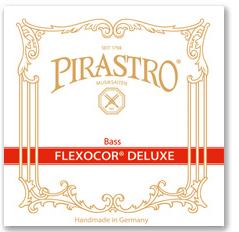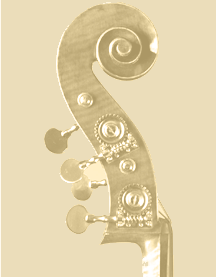Solo Upright Bass Strings
 Solo
upright bass strings are usually slightly thinner and higher tensioned strings
that are designed to be played a whole step higher: That is, a G
string is then tuned to an A, the D string up to an E, the A up to a B and
the E, becomes F#. Solo
upright bass strings are usually slightly thinner and higher tensioned strings
that are designed to be played a whole step higher: That is, a G
string is then tuned to an A, the D string up to an E, the A up to a B and
the E, becomes F#.
Why do this, when did this start and what are the results?
You may have heard of a very famous violinist, Niccolo Paganini that
lived in the early 1800's (died in 1840) that would tune his violin
up 1/2 step. He'd tune the D up to and Eflat (D#) and so all
the while the orchestra played in his sounding key: Eb Major, he
would be playing in an easier key and make his fiddle sound great!
This did at least two things for Paganini's sound. One, it
pushed the projection of the instrument (adding tension) so that it
would be louder and at the same time, changed the tone, adding
brightness to the instrument so that the tone quality (timbre) would
be brighter, easier to discern from the rest of the violins and even
heard in the back of the concert hall. Don't forget that they
didn't have today's engineered Thomastik Dominants or Evah Pirazzi
metal or synthetic strings....just gut!
Changing pitches and tunings of open strings is nothing new to
bass players. There are the old Viennese style tunings.
See our special
Viennese
Tuning page for a little history. The epic bass concertos
like the Vanhal and Dittersdorf where meant for basses tuned in
3rds. It's actually easier to play these concertos in with
this tuning, but still a hassle when the same player needs to then
play audition excerpts in regular tunings (in 4ths). This is
one (good) reason why today's bass players to mess with the
different tunings.
Even back in the 1820's Prague, there is mention of solo tuning by
the Harmonicon magazine that in order make a "naturally harsh
tone of the double bass as pleasing as possible players would raise
the string a half tone". Ok, I take umbrance with that
"harsh" word, but anyhow, tuning thin gut strings sounded and
responded so much better than the thick, slow speaking ones.
The only way to get the thin guts to work and not be too loose, was
to tune them up. This was the start of "solo" tuning. By
the way, famous bass soloist (1763-1846) Dragonetti, never used solo
strings. He'd play his concertos with the string high off the
fingerboard (adding the tension) and he'd play the hell out of his
bass! He also had the biggest mits anyone had ever seen!
These days most all buy gut strings to either play recitals or
concertos. Some players though buy them to tune them at
'orchestra' pitch: EADG There are some good reasons for this
and why. First, while the solo strings are meant and designed
to be tuner at the higher tensions, tuning them at the regular pitch
(EADG) will be a much looser string then say the same brand, but
thicker gauge. For players that have tight hand issues,
tendonitis, or joint pain issues, these strings are easier to pull
down. Sometimes the trade off is that could be so loose on the
bass that buzz or not respond quick enough with the bow. Jazz
musicians still buy solo gauge Spirocore strings and tune them down.
Getting a nicer, easier bass, looser feel and sometimes even more
sustain. One way to think of solo strings is that they are
just light tension strings that you can tune up at higher pitch.
Also, in some rare cases, some basses just won't work with the
regular orchestra medium gauge strings (even light), and will open
up sound-wise and play better with solo strings tuned down.
Some more facts about the playing aspects of upright
bass solo strings:
-they tend to have a quicker response under the bow (when tuned
correctly at pitch.)
-they tend to make the bass sound a little more articulate and a
little brighter
-even though they are specially designed to be tuned up, they do add
a little more tension to the bass top
-They do make the bass sound more cello-ish
-tuning them down at regular orchestra pitch will give you a looser
feeling string, less tension in the left hand
-our most popular solo strings: Belcanto, Pirastro's Passsione
(sound a bit darker than Belcanto...at least on my bass), Flexocor
(tone right in the middle) and of course Spirocores (the brightest
sound) but what the heck...you're a soloist now and might as well
project!! Again, it will always depend on your bass and your taste.
So, now at least you know (just a little more) about upright bass
solo strings and why they came about. Did you know that we have the
best deals and prices on
upright bass strings?
|


